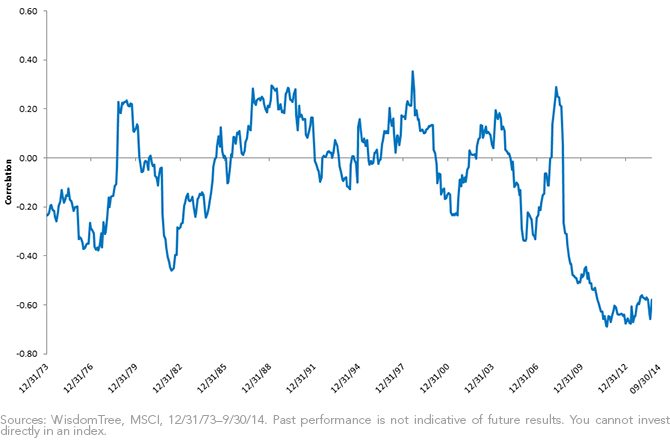What a Rising Dollar Means for Your Stock Portfolio


 Who Benefits from a Strengthening Dollar?
• International Equities: Foreign multinational companies have the potential to benefit from a strengthening dollar because their products become less expensive to U.S. consumers, possibly increasing sales. These companies also benefit as their foreign sales are translated back to their home currency through a more favorable exchange rate, resulting in higher earnings. We think this is why developed international equities have historically performed better in periods when their currencies were weakening, compared to periods when they were strengthening.6 Even though a stronger U.S. dollar and weaker euro or yen might help the profits of European or Japanese companies, the dollar strength can drag down the total returns of U.S. investors who do not hedge their international equity exposure. For this, we encourage investors to consider Japanese and European multinational companies, where we see some of the strongest examples of U.S. dollar strength relative to these currencies.
• Domestic Small Caps: Typically, small-cap companies generate a majority of their sales domestically and are not as sensitive to movements in exchange rates as large caps. Also, domestic small caps are typically not impacted by foreign economic growth, which has been tepid compared to U.S. growth.
1Tony Sagami, “The Ticking Time Bomb of the Strong US Dollar,” Mauldin Economics, 10/28/14.
2Ibid.
3The Coca-Cola Company, Third Quarter and Year-to-Date 2014 Results, 10/21/14.
4Philip Morris International Inc., 2014 Third-Quarter Results, 10/16/14.
5The Procter & Gamble Company, Q1 2015 Earnings Release, 10/24/14.
6Sources: WisdomTree, Bloomberg, 12/31/69–09/30/14. Refers to the currencies and equities in the MSCI EAFE Index.
Who Benefits from a Strengthening Dollar?
• International Equities: Foreign multinational companies have the potential to benefit from a strengthening dollar because their products become less expensive to U.S. consumers, possibly increasing sales. These companies also benefit as their foreign sales are translated back to their home currency through a more favorable exchange rate, resulting in higher earnings. We think this is why developed international equities have historically performed better in periods when their currencies were weakening, compared to periods when they were strengthening.6 Even though a stronger U.S. dollar and weaker euro or yen might help the profits of European or Japanese companies, the dollar strength can drag down the total returns of U.S. investors who do not hedge their international equity exposure. For this, we encourage investors to consider Japanese and European multinational companies, where we see some of the strongest examples of U.S. dollar strength relative to these currencies.
• Domestic Small Caps: Typically, small-cap companies generate a majority of their sales domestically and are not as sensitive to movements in exchange rates as large caps. Also, domestic small caps are typically not impacted by foreign economic growth, which has been tepid compared to U.S. growth.
1Tony Sagami, “The Ticking Time Bomb of the Strong US Dollar,” Mauldin Economics, 10/28/14.
2Ibid.
3The Coca-Cola Company, Third Quarter and Year-to-Date 2014 Results, 10/21/14.
4Philip Morris International Inc., 2014 Third-Quarter Results, 10/16/14.
5The Procter & Gamble Company, Q1 2015 Earnings Release, 10/24/14.
6Sources: WisdomTree, Bloomberg, 12/31/69–09/30/14. Refers to the currencies and equities in the MSCI EAFE Index.Important Risks Related to this Article
Foreign investing involves special risks, such as risk of loss from currency fluctuation or political or economic uncertainty. Investments focusing on certain sectors and/or smaller companies increase their vulnerability to any single economic or regulatory development. Investments focused in Japan are increasing the impact of events and developments associated with the region, which can adversely affect performance.

Jeremy Schwartz has served as our Global Chief Investment Officer since November 2021 and leads WisdomTree’s investment strategy team in the construction of WisdomTree’s equity Indexes, quantitative active strategies and multi-asset Model Portfolios. Jeremy joined WisdomTree in May 2005 as a Senior Analyst, adding Deputy Director of Research to his responsibilities in February 2007. He served as Director of Research from October 2008 to October 2018 and as Global Head of Research from November 2018 to November 2021. Before joining WisdomTree, he was a head research assistant for Professor Jeremy Siegel and, in 2022, became his co-author on the sixth edition of the book Stocks for the Long Run. Jeremy is also co-author of the Financial Analysts Journal paper “What Happened to the Original Stocks in the S&P 500?” He received his B.S. in economics from The Wharton School of the University of Pennsylvania and hosts the Wharton Business Radio program Behind the Markets on SiriusXM 132. Jeremy is a member of the CFA Society of Philadelphia.

